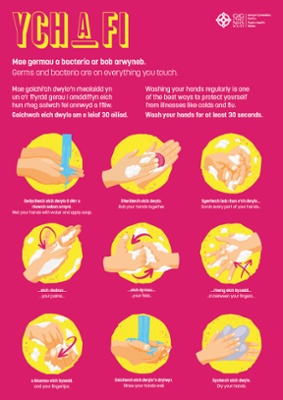How do I ensure my workplace is a safe environment with good infection prevention and control?
The best way to ensure good infection prevention and control is by promoting and maintaining good hygiene practices among your staff and visitors and throughout the workplace environment.

Hand Hygiene
- Provide suitable and sufficient hand washing facilities with running hot and cold or warm water, soap and hand drying.
- Provide alcohol hand sanitiser (where appropriate) to supplement good hand hygiene (e.g. when handwashing facilities are not easily accessible).
- Display visible signage outlining best hygiene practice and reminders to wash hands regularly and, as a minimum, after visiting the washroom, blowing nose, sneezing/coughing, and before eating. Some workplaces will have additional hand hygiene requirements that also need to be highlighted, e.g. in health, social care and childcare settings as well as food premises.
- Signage should be particularly prominent in areas with a high risk of contamination such as communal spaces, kitchens and washrooms.
- Additional signage should be considered if there has been an increase in infections in the workplace or wider community.
A Clean Environment
- Develop a cleaning schedule for all areas with details of cleaning frequency, cleaning methods and equipment as well as cleaning/disinfecting products to be used. It should identify who has responsibility for undertaking the cleaning in each area, e.g. office staff may be responsible for cleaning their own desk or IT equipment, cleaners may be employed to clean specific areas.
- Cleaning frequency should be based on risk, with higher risk areas including:
- Washrooms, kitchens and communal areas
- Frequent touch points that are in contact with hands, e.g. door handles and light switches as well as equipment such as photocopiers, microwaves or kettles.
- Display and monitor cleaning record logs in communal areas and washrooms to ensure regular cleaning is being undertaken. These should be initialled, dated with the time specified by the person who has done the cleaning.
- Ensure cleanliness and reduce clutter in communal spaces. Display signage asking people to clean and put away shared items such as mugs, cutlery and crockery after use.
- Provide appropriate waste bins to separate and segregate waste in accordance with national requirements.
Ventilation
Improving ventilation in the workplace can also help reduce infection transmission. Risk assess what actions can be taken in areas of poor ventilation, e.g. opening doors, windows or vents or ensuring mechanical ventilation is functioning. HSE provides advice on improving ventilation in the workplace.